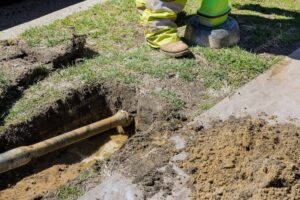As technology continues to advance, the trenchless industry is poised to evolve and offer even more robust solutions to solve the unique challenges presented by cold climates.
Trenchless pipe repair has revolutionized how we address underground infrastructure issues, offering a more environmentally friendly alternative to traditional excavation methods. By minimizing ground disturbance and reducing the need for extensive digging, trenchless methods contribute to the preservation of landscapes and ecosystems.
This blog will delve into the challenges and solutions associated with trenchless pipe repair in cold climates, shedding light on the intricacies of maintaining and repairing underground infrastructure in regions with harsh winter conditions.
Challenges in Cold Climate Trenchless Pipe Repair
Freezing temperatures and ground conditions: Cold climates bring freezing temperatures that pose significant challenges to trenchless pipe repair. Frozen ground can make it difficult to conduct operations efficiently, and the risk of pipes freezing during repairs adds an extra layer of complexity.
Risk of frost heaving and ground settlement: Frost heaving, where the ground swells due to moisture freezing, and ground settlement, caused by thawing, are common issues in cold climates. These phenomena can compromise the integrity of underground structures and exacerbate existing problems.
Difficulty in accessing and inspecting underground infrastructure during winter: The winter often hampers the ability to access and inspect underground pipes and utilities effectively. Snow and ice cover can hinder the identification of potential issues, making it challenging to plan and execute repairs.
Material considerations in sub-zero temperatures: Some materials used in trenchless pipe repair may behave differently in sub-zero temperatures, potentially impacting their effectiveness. Understanding how these materials respond to extreme cold is crucial for ensuring the longevity of the repaired infrastructure.
Safety concerns for workers in cold conditions: Cold climates pose health and safety risks for plumbers involved in trenchless pipe repair. Exposure to low temperatures increases the likelihood of cold-related illnesses and injuries, making it imperative to implement comprehensive safety measures.
Trenchless Methods for Cold Climates
Certain trenchless methods are better suited for cold climates than others. Methods such as pipe bursting, directional drilling, and cured-in-place pipe (CIPP) lining offer efficient solutions with minimal disruption.
Maintaining a heated water supply is crucial for trenchless operations in cold climates. Ensuring that water temperatures remain above freezing is essential to prevent complications during the repair process.
Trenchless operations in cold climates may require specialized equipment to withstand low temperatures. This includes tools with insulation and heating capabilities to prevent freezing and maintain optimal functionality.
Incorporating frost protection measures into trenchless operations helps mitigate the impact of cold weather. Insulating equipment and pipes can prevent freezing and ensure consistent performance.

Preparations and Planning
Site-specific considerations for cold climate trenchless projects: Each trenchless project in a cold climate has unique challenges. Understanding the site’s specific conditions, including soil composition and groundwater levels, is essential for effective planning.
Importance of geotechnical and weather data: Accurate geotechnical and weather data are indispensable for planning trenchless projects in cold climates. This information guides decisions related to equipment selection, material choices, and project timelines.
Project scheduling to mitigate cold weather challenges: Scheduling trenchless projects during milder weather can help minimize the impact of cold conditions. Planning repairs strategically allows for more favorable working conditions and reduces the likelihood of weather-related setbacks.
Contingency planning for unexpected winter conditions: Unpredictable weather events can occur in cold climates. Having robust contingency plans in place ensures that unforeseen challenges can be addressed promptly, minimizing project delays and cost overruns.
- Ground Thawing Techniques
Thawing frozen ground is a critical step in preparing for trenchless operations in cold climates. Ground heaters, steam generators, and hot water injection systems are effective tools for thawing frozen ground. These methods help create a conducive environment for trenchless operations by preventing the ground from impeding progress.
While ground thawing is essential, it must be conducted with safety in mind. Implementing safety measures, such as monitoring ground temperatures and using appropriate thawing equipment, ensures the well-being of workers and the success of the project.
- Material Selection for Cold Weather
Selecting materials that can withstand sub-zero temperatures is crucial for the success and longevity of trenchless repairs in cold climates. This includes pipes, liners, and sealing materials that exhibit resilience in extreme cold.
Cold temperatures can affect the properties of materials commonly used in trenchless pipe repair. Brittle fracture, reduced flexibility, and diminished tensile strength are among the challenges that materials may face in cold climates. Consequently, a comprehensive understanding of how these materials respond to low temperatures is indispensable for guaranteeing the long-term success of the repair work.
A critical consideration in material selection for cold weather trenchless repairs involves the incorporation of insulation and protective coatings. These additional layers serve as a defense mechanism against the adverse impacts of cold climates.
Insulation acts as a thermal barrier, preventing the formation of ice within the pipes and maintaining the structural integrity of the repaired infrastructure. Protective coatings, on the other hand, create a shield against external elements, such as corrosive agents or abrasive substances, which can exacerbate the impact of cold weather on the materials.
By integrating insulation and protective coatings into the material selection process, engineers and project managers enhance the resilience of the repaired pipes, ensuring that they can withstand the rigors of cold climates over the long term. This proactive approach not only mitigates the risk of freezing but also contributes significantly to the overall longevity and performance of the rehabilitated infrastructure.
- Safety and Worker Comfort
Implementing stringent safety protocols and providing appropriate protective gear is paramount for the well-being of trenchless workers in cold climates. This includes insulated clothing and proper footwear to avoid cold-related illnesses.
Educating workers on the risks of cold-related illnesses and injuries is crucial. Implementing measures such as regular breaks, warm-up areas, and monitoring workers’ health ensures a safer working environment.
Cold climates can affect worker morale and productivity. Implementing strategies to boost morale, such as providing warm beverages and ensuring comfortable break areas, contributes to a positive work atmosphere.
- Environmental Considerations
Trenchless repair in cold climates aligns with environmental sustainability goals by minimizing ground disturbance and reducing the carbon footprint associated with excavation. This approach helps preserve ecosystems and reduces the release of harmful emissions associated with heavy machinery.
Embracing eco-friendly materials and practices further enhances the environmental sustainability of trenchless pipe repair in cold climates. From choosing the materials to managing waste, incorporating green practices contributes to a more sustainable and responsible approach.
Conclusion
Trenchless pipe repair in cold climates presents a unique challenge that demands innovative solutions. Trenchless professionals can successfully navigate these challenges by understanding the intricacies of freezing temperatures, ground conditions, and material considerations. For more information about trenchless repair, contact us today.




